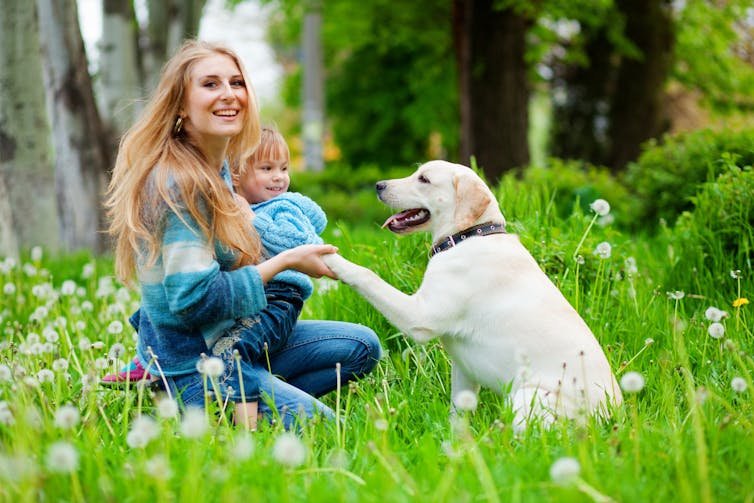Anna Baatz, University of Salford
It’s no wonder owning a family dog is popular in the UK – research shows that our wellbeing can increase with dog ownership, and there’s even evidence that children’s development can benefit if they share their home with a dog.
Unfortunately though, hospital admissions for dog bites are more likely to be children than adults. The majority of bites on children are from a dog known to them. And many bites happen while a parent or caregiver is actually present.
Popular representations of dogs as the perfect addition to a family are everywhere, from the 1904 JM Barrie Novel Peter Pan and Nana, to today’s children’s television. The movie, The Secret Life of Pets 2 opens with Max, the charismatic terrier complaining that he doesn’t personally love kids and is grateful for not living with them and being “piled on” by “hordes of children”. Max is soon faced with a new child in the family, Liam, and he laments he doesn’t feel safe in his own home.
Although Max’s predicament is played for laughs, the truth is children can make dogs’ lives difficult and uncomfortable. We certainly don’t want our children to be bitten. But it’s easy to overlook the dog’s perspective.
Power of play
Safe play means no shouting or roughness. Fetch, for example, can be great but be mindful if your dog is “guarding” by not relinquishing or snapping for their favourite toys. You and your children should teach your dog a leave command by trading toys for treats. Immediately throwing a second toy as soon as they bring the first back can also discourage guarding. My own son finds this game lots of fun with our dog.

Alena Ozerova/Shutterstock
During play all four paws should be on the floor. If your dog becomes over excited during play, for example jumping up or mouthing, it’s better to just ask your child to step away and both have a bit of a time out, than shouting or punishing your dog.
But that doesn’t mean children should be discouraged from playing with the family dog. Play is something children are usually better at than adults. Parents I interviewed for my research into children’s interactions with a family dog said their kids don’t tire of throwing a ball or playing tug. And for dogs, play is a natural behaviour that they don’t grow out of.
Cuddles aren’t always cute
While thousands of animal cuddly toys are squished by children the world over, it’s worth remembering that cuddling is a mostly human behaviour.
Research has shown that some dogs can learn to tolerate cuddles, some even enjoy them. But they are not something that dogs innately find enjoyable and research shows that many dogs don’t get an oxytocin (cuddle hormone) response to it.
Close physical contact between children and the family dog is a common reason dogs show aggression towards a child. So children should be discouraged from putting their arms around a dog, leaning on, or picking them up, in favour of other ways of showing affection in which the dog has more freedom of choice.
A dog needs freedom of choice
It’s impossible to allow dogs to do whatever they like all the time. Their behaviour has to fit into what we are willing to accept as their human owners after all. Nonetheless dogs living with children can react aggressively if children restrict their ability to choose what they want to do, for example physically restrictive cuddles, or interrupting them when they are in the middle of resting, eating or playing alone.
It isn’t difficult to allow your dog some choice in affectionate interactions from children. Simply encouraging the kids to call the dog over to them where they are sitting, rather than approaching the dog themselves, can make a difference. And remind children not to follow the dog if he or she moves away from them. In my recent study parents also found that their dogs were more likely to value their space from the kids at night time or when they were tired.
Don’t expect children to read dogs
Dogs can’t talk. Imagine if they could. Perhaps then we’d be better at understanding their needs. Instead, they mostly use their bodies to communicate.
Research has shown that young children are generally not good at recognising dog body language or facial expressions. My 2023 study of UK families showed that even if they could recognise their dog was unhappy about an interaction, it didn’t make the child stop it. And a 2016 study found that parents who owned a dog didn’t notice common signs of anxiety, such as a dog licking their lips or nose, wide eyes, yawning out of context or leaning away from the child.
If your child can learn how to spot how dogs show certain emotions that’s great. There’s lots of resources available online . But don’t expect that alone to be a panacea of all interaction problems or risks.
The fact that dogs have emotions too means there is always a possibility an interaction might not go well. Which is why it is not just supervision, but involved supervision that will help your dog and kids become best of friends.![]()
Anna Baatz, PhD Candidate and Associate Lecturer in human-animal interactions, University of Salford
This article is republished from The Conversation under a Creative Commons license. Read the original article.


Recent Comments